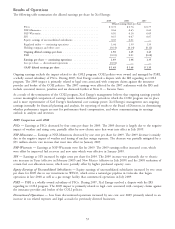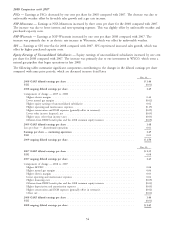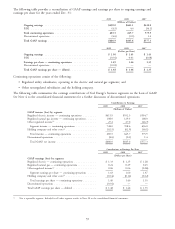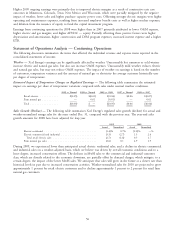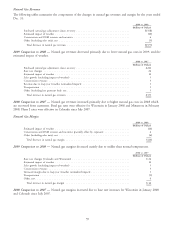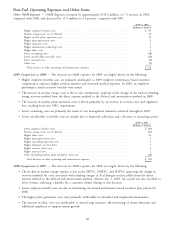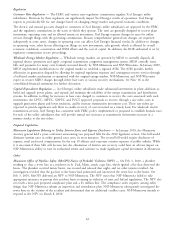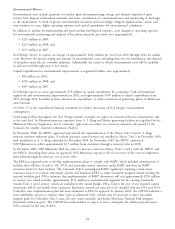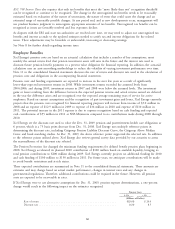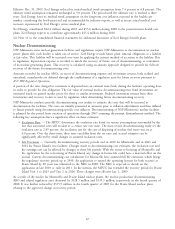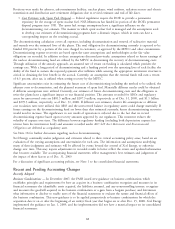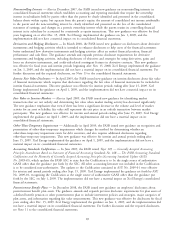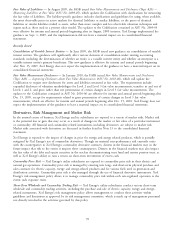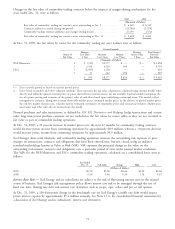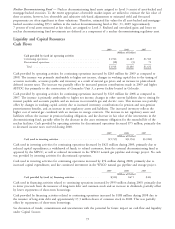Xcel Energy 2009 Annual Report Download - page 73
Download and view the complete annual report
Please find page 73 of the 2009 Xcel Energy annual report below. You can navigate through the pages in the report by either clicking on the pages listed below, or by using the keyword search tool below to find specific information within the annual report.Regulation
Customer Rate Regulation — The FERC and various state regulatory commissions regulate Xcel Energy’s utility
subsidiaries. Decisions by these regulators can significantly impact Xcel Energy’s results of operations. Xcel Energy
expects to periodically file for rate changes based on changing energy market and general economic conditions.
The electric and natural gas rates charged to customers of Xcel Energy’s utility subsidiaries are approved by the FERC
and the regulatory commissions in the states in which they operate. The rates are generally designed to recover plant
investment, operating costs and an allowed return on investment. Xcel Energy requests changes in rates for utility
services through filings with the governing commissions. Because comprehensive general rate changes are requested
infrequently in some states, changes in operating costs can affect Xcel Energy’s financial results. In addition to changes
in operating costs, other factors affecting rate filings are new investments, sales growth, which is affected by overall
economic conditions, conservation and DSM efforts and the cost of capital. In addition, the ROE authorized is set by
regulatory commissions in rate proceedings.
Wholesale Energy Market Regulation — Wholesale energy markets are operated by MISO to centrally dispatch all
regional electric generation and apply a regional transmission congestion management system. MISO centrally issues
bills and payments for many costs formerly incurred directly by NSP-Minnesota and NSP-Wisconsin. In January 2009,
MISO implemented modifications to the original market to establish a regional ASM. The ASM provides further
efficiencies in generation dispatch by allowing for regional regulation response and contingency reserve services through
a bid-based market mechanism co-optimized with the original energy market. NSP-Minnesota and NSP-Wisconsin
expect to recover MISO charges through either base rates or various recovery mechanisms. See Note 16 to the
consolidated financial statements for further discussion.
Capital Expenditure Regulation — Xcel Energy’s utility subsidiaries make substantial investments in plant additions to
build and upgrade power plants, and expand and maintain the reliability of the energy transmission and distribution
systems. In addition to filing for increases in base rates charged to customers to recover the costs associated with such
investments, the CPUC, MPUC, SDPUC and PUCT approved proposals to recover, through a rate rider, costs to
upgrade generation plants and lower emissions, and/or increase transmission investment cost. These rate riders are
expected to provide significant cash flows to enable recovery of costs incurred on a timely basis. For wholesale electric
transmission services, Xcel Energy has, consistent with FERC policy, implemented or proposed to establish formula rates
for each of the utility subsidiaries that will provide annual rate increases as transmission investments increase in a
manner similar to the rate riders.
Proposed Legislation
Minnesota Legislation Relating to Utility Interim Rates and Expense Disclosure — In January 2010, the Minnesota
attorney general held a press conference announcing two proposed bills for the 2010 legislative session. One bill would
eliminate interim rates in utility general rates cases, in most instances. The second bill would require disclosure of
expense, meal and travel compensation for the top 10 officers and corporate aviation expenses of public utilities. While
it is uncertain if these bills will become law, the elimination of interim rate recovery could have an adverse impact on
NSP-Minnesota’s ability to earn its authorized return and continue to make significant capital investment in Minnesota.
Other
Minnesota Office of Pipeline Safety (MnOPS)-Notice of Probable Violation (NPV) — On Feb. 1, 2010, a plumber
working to clear a sewer line at a residence in St. Paul, Minn. struck a gas line, which ignited a fire that destroyed the
house. The plumber received minor burns, was treated and released that night, and no other injuries resulted. An
investigation revealed that the gas line to the house had penetrated and intersected the sewer line to the home. On
Feb. 5, 2010, MnOPS delivered an NPV to NSP-Minnesota. The NPV states that NSP-Minnesota failed to take
appropriate measures to prevent this accident from occurring in violation of state and federal regulations. The NPV also
sets forth a four-part proposed compliance plan and a $1 million fine. The compliance order requires, among other
things, that NSP-Minnesota submit an inspection and remediation plan. NSP-Minnesota subsequently investigated the
sewer lines in the vicinity of the accident and determined that no additional conflicts exist. NSP-Minnesota intends to
respond to the NPV on March 8, 2010.
63


